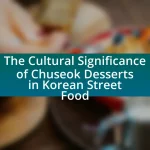Korean desserts, characterized by their diverse flavors and cultural significance, are gaining global popularity, particularly through street food innovations. This article explores the evolution of traditional Korean sweets, such as tteok and bingsu, and their integration into international cuisine, influenced by social media and Korean pop culture. It highlights the role of regional variations and traditional ingredients in shaping dessert recipes, as well as the impact of street food culture on consumer preferences. Additionally, the article discusses how local businesses can capitalize on the Korean dessert trend and offers tips for recreating these popular treats at home.

What are Korean Desserts and Their Cultural Significance?
Korean desserts are a variety of sweet dishes that reflect the country’s culinary traditions and cultural values. These desserts, such as tteok (rice cakes), bingsu (shaved ice), and hotteok (sweet pancakes), often incorporate ingredients like rice, beans, fruits, and nuts, showcasing the importance of seasonal and local produce in Korean cuisine. The cultural significance of these desserts lies in their role during celebrations and rituals, such as birthdays and holidays, where they symbolize prosperity and good fortune. For example, the traditional rice cake, tteok, is often served during celebrations like Chuseok (Korean harvest festival) and is believed to bring blessings to the family. This connection between desserts and cultural practices highlights how Korean sweets are not merely food items but also integral to social and familial bonds.
How have Korean desserts evolved over time?
Korean desserts have evolved significantly over time, transitioning from traditional rice-based sweets to a diverse array of modern confections influenced by global culinary trends. Historically, desserts like tteok (rice cakes) and hangwa (traditional sweets) were staples, often made for celebrations and rituals. In recent decades, the introduction of Western ingredients and techniques has led to the creation of innovative desserts such as bingsu (shaved ice) and fusion pastries, reflecting a blend of traditional and contemporary flavors. This evolution is evidenced by the rise of dessert cafes in South Korea, which have gained popularity both domestically and internationally, showcasing the adaptability and creativity of Korean dessert culture.
What traditional ingredients are commonly used in Korean desserts?
Traditional ingredients commonly used in Korean desserts include rice flour, red bean paste, and sweetened fruits. Rice flour serves as a base for many desserts, such as tteok (rice cakes), which are often filled with red bean paste, a staple in Korean sweets. Additionally, sweetened fruits like jujubes and persimmons are frequently incorporated to enhance flavor and texture. These ingredients reflect the cultural significance and culinary practices in Korea, where desserts often emphasize natural sweetness and texture.
How do regional variations influence Korean dessert recipes?
Regional variations significantly influence Korean dessert recipes by incorporating local ingredients and traditional practices unique to each area. For instance, Jeju Island is known for its use of tangerines, leading to desserts like tangerine rice cakes, while the mountainous regions often utilize chestnuts and wild herbs, resulting in distinct flavors and textures. Additionally, the cultural heritage of each region shapes the preparation methods and presentation styles, reflecting local customs and seasonal availability of ingredients. This diversity not only enriches the overall landscape of Korean desserts but also highlights the adaptability of these recipes to regional tastes and preferences.
Why are Korean desserts gaining popularity worldwide?
Korean desserts are gaining popularity worldwide due to their unique flavors, visually appealing presentations, and the influence of Korean pop culture. The rise of social media platforms has allowed visually striking desserts like bingsu and tteok to reach a global audience, showcasing their aesthetic appeal. Additionally, the increasing interest in Korean cuisine, driven by the Korean Wave (Hallyu), has led to a greater appreciation for traditional and modern Korean sweets. According to a report by the Korea Agro-Fisheries & Food Trade Corporation, the global market for Korean food, including desserts, has seen significant growth, indicating a rising demand for these culinary delights.
What role does social media play in promoting Korean desserts?
Social media plays a crucial role in promoting Korean desserts by providing a platform for visual storytelling and engagement. Platforms like Instagram and TikTok allow users to share appealing images and videos of Korean desserts, which enhances their visibility and attractiveness to a global audience. For instance, the hashtag #KoreanDesserts has garnered millions of posts, showcasing a variety of treats such as bingsu and tteok, which helps to create trends and drive interest. Additionally, influencers and food bloggers often highlight these desserts, further amplifying their reach and encouraging followers to try them. This digital exposure has significantly contributed to the growing popularity of Korean desserts worldwide, as evidenced by increased searches and demand for these items in international markets.
How do Korean dramas and pop culture impact dessert trends?
Korean dramas and pop culture significantly influence dessert trends by popularizing unique Korean sweets and desserts globally. The visual appeal and frequent depiction of desserts in these dramas, such as bingsu (shaved ice) and tteok (rice cakes), create a desire among viewers to experience these treats. For instance, the rise of social media platforms has amplified this effect, as fans share images and recipes inspired by their favorite shows, leading to increased demand for Korean desserts in various countries. This cultural exchange has resulted in the adaptation of traditional Korean desserts into local markets, showcasing their growing popularity and impact on global dessert trends.

How is Street Food Shaping the Korean Dessert Scene?
Street food is significantly shaping the Korean dessert scene by introducing innovative flavors and presentation styles that appeal to a diverse audience. Vendors are creatively combining traditional ingredients like red bean, rice cakes, and seasonal fruits with modern techniques, resulting in unique offerings such as bingsu (shaved ice) and hotteok (sweet pancakes). This fusion not only enhances the accessibility of Korean desserts but also promotes cultural exchange, as street food markets attract both locals and tourists. The popularity of these desserts is evidenced by the rapid growth of street food festivals and dessert cafes in urban areas, reflecting a shift in consumer preferences towards experiential and visually appealing food options.
What are the most popular street desserts in Korea?
The most popular street desserts in Korea include tteokbokki, hotteok, bungeoppang, and patbingsu. Tteokbokki, a spicy rice cake dish, is often enjoyed as a snack but can also be sweetened for dessert variations. Hotteok, a filled pancake, is typically served warm with a sweet syrup inside. Bungeoppang, a fish-shaped pastry filled with red bean paste, is a beloved winter treat. Patbingsu, a shaved ice dessert topped with various ingredients like sweetened red beans, fruits, and condensed milk, is especially popular during the summer months. These desserts reflect Korea’s rich culinary culture and have gained international popularity, influencing global dessert trends.
How are these street desserts prepared and served?
Street desserts in Korea are typically prepared by combining traditional ingredients with modern techniques, often cooked in open-air stalls. Common preparations include frying, steaming, or grilling, with popular items like hotteok (sweet pancakes filled with brown sugar) and bungeoppang (fish-shaped pastries filled with red bean paste). These desserts are served fresh and hot, often in disposable containers or on skewers for easy consumption while walking. The use of vibrant toppings and sauces enhances their appeal, making them visually enticing and flavorful.
What makes street desserts appealing to both locals and tourists?
Street desserts are appealing to both locals and tourists due to their unique flavors, accessibility, and cultural significance. The diverse range of ingredients and innovative combinations found in street desserts, such as bingsu and hotteok, attract food enthusiasts seeking authentic culinary experiences. Additionally, the convenience of street vendors allows easy access to these treats, making them popular among busy locals and curious tourists alike. The cultural context of these desserts, often tied to local traditions and festivals, enhances their allure, as they offer a taste of the region’s heritage.
How does the street food experience enhance the enjoyment of Korean desserts?
The street food experience enhances the enjoyment of Korean desserts by providing an immersive and interactive environment that engages multiple senses. This setting allows consumers to witness the preparation of desserts like bingsu and hotteok, which adds a layer of excitement and anticipation. The vibrant atmosphere of street markets, characterized by lively interactions and the aroma of freshly made treats, creates a unique context that elevates the tasting experience. Additionally, the accessibility of these desserts in street food settings encourages sampling and sharing, fostering a communal enjoyment that is integral to Korean culture. This combination of sensory engagement, cultural context, and social interaction significantly amplifies the overall enjoyment of Korean desserts.
What unique aspects of street food culture contribute to dessert popularity?
Street food culture significantly contributes to dessert popularity through its accessibility, variety, and social experience. The convenience of street vendors allows consumers to easily try diverse dessert options, often at lower prices than traditional restaurants. Additionally, the vibrant atmosphere of street food markets encourages sharing and sampling, fostering a communal experience that enhances the enjoyment of desserts. For instance, in South Korea, popular street desserts like bingsu and hotteok have gained international attention, showcasing how local flavors and innovative presentations attract a global audience. This trend is supported by the rise of social media, where visually appealing desserts are widely shared, further driving their popularity.

What Global Trends are Influenced by Korean Desserts?
Korean desserts are influencing global trends in the culinary world, particularly through the rise of unique flavors and presentation styles. The popularity of items like bingsu (shaved ice) and tteok (rice cakes) has led to an increased interest in Asian-inspired desserts across various regions, including North America and Europe. This trend is supported by the growing demand for fusion cuisine, where traditional Korean elements are combined with local ingredients, creating innovative dessert offerings. Additionally, social media platforms have amplified the visibility of these desserts, driving consumer interest and encouraging food entrepreneurs to incorporate Korean dessert concepts into their menus.
How are Korean desserts being integrated into international cuisine?
Korean desserts are being integrated into international cuisine through the growing popularity of items like bingsu and tteok, which are increasingly featured in global dessert menus. This integration is evidenced by the rise of Korean dessert cafes in major cities worldwide, such as New York and Los Angeles, where traditional elements are combined with local flavors to create fusion desserts. Additionally, social media platforms have played a significant role in showcasing these desserts, leading to increased demand and adaptation by chefs outside Korea, who incorporate Korean ingredients and techniques into their offerings.
What fusion desserts are emerging from the popularity of Korean sweets?
Fusion desserts emerging from the popularity of Korean sweets include items like Korean-style macarons, bingsu-inspired ice cream sundaes, and matcha-infused tteok cakes. These desserts combine traditional Korean ingredients, such as red bean paste and mochi, with Western dessert concepts, creating unique flavor profiles and textures. For instance, the incorporation of bingsu, a shaved ice dessert, into ice cream sundaes has gained traction, blending the refreshing qualities of bingsu with the creaminess of ice cream. This trend reflects a broader movement where global culinary influences merge, showcasing the adaptability and appeal of Korean flavors in contemporary dessert culture.
How are chefs around the world adapting Korean dessert techniques?
Chefs around the world are adapting Korean dessert techniques by incorporating traditional elements like mochi and bingsu into their menus, often blending them with local flavors. For instance, in the United States, some pastry chefs are creating fusion desserts that combine Korean rice cakes with American flavors such as matcha cheesecake or chocolate ganache. This adaptation reflects a growing trend where chefs are experimenting with textures and ingredients unique to Korean desserts, such as sweet red bean paste and seasonal fruits, to appeal to diverse palates. The popularity of Korean desserts has surged, evidenced by the increasing number of Korean dessert cafes opening globally, which further validates this culinary shift.
What lessons can other cultures learn from the rise of Korean desserts?
Other cultures can learn the importance of innovation and adaptation from the rise of Korean desserts. The success of Korean desserts, such as bingsu and tteok, demonstrates how traditional recipes can be modernized to appeal to contemporary tastes, as seen in the fusion of flavors and ingredients that attract a global audience. For instance, the incorporation of seasonal fruits and unique toppings in bingsu has made it a popular choice beyond Korea, showcasing the potential for cultural exchange and culinary creativity. This adaptability not only preserves cultural heritage but also enhances its relevance in a globalized food market, encouraging other cultures to explore and innovate within their own culinary traditions.
How can local businesses capitalize on the Korean dessert trend?
Local businesses can capitalize on the Korean dessert trend by incorporating popular items like bingsu and tteok into their menus. This trend is driven by the increasing global interest in Korean culture, evidenced by the 2021 report from the Korean Tourism Organization, which noted a 30% rise in international visitors seeking Korean culinary experiences. By offering authentic Korean desserts, local businesses can attract customers looking for unique dining experiences, thereby increasing foot traffic and sales. Additionally, collaborating with local influencers to promote these desserts can enhance visibility and engagement within the community.
What are some tips for making Korean desserts at home?
To make Korean desserts at home, focus on using authentic ingredients and techniques. Start by sourcing key components like glutinous rice flour, red bean paste, and sweet rice flour, which are essential for traditional desserts such as tteok and bingsu. Utilize recipes that emphasize the balance of flavors and textures, as Korean desserts often combine sweet, chewy, and creamy elements. For example, when making tteok, ensure to steam the rice flour mixture properly to achieve the desired chewy consistency. Additionally, pay attention to presentation, as aesthetics play a significant role in Korean dessert culture; garnishing with fruits or nuts can enhance visual appeal.
What essential ingredients should you stock for Korean dessert recipes?
Essential ingredients to stock for Korean dessert recipes include glutinous rice flour, red bean paste, sweet rice flour, and various fruits like strawberries and mangoes. Glutinous rice flour is crucial for making traditional desserts such as tteok, while red bean paste serves as a common filling in many sweets. Sweet rice flour is used in dishes like injeolmi, and fruits add freshness and flavor to desserts like bingsu. These ingredients are foundational in creating authentic Korean desserts that reflect the country’s culinary heritage.
How can you recreate popular street desserts in your kitchen?
To recreate popular street desserts in your kitchen, start by identifying the key ingredients and techniques used in those desserts. For example, to make Korean hotteok, you need flour, sugar, yeast, and a filling of brown sugar, cinnamon, and nuts. Combine these ingredients to form a dough, let it rise, fill it, and then pan-fry until golden brown. This method mirrors the traditional street preparation, ensuring authenticity. Additionally, using recipes from reputable sources, such as cooking blogs or culinary books focused on Korean cuisine, can provide accurate measurements and techniques, reinforcing the validity of your approach.


